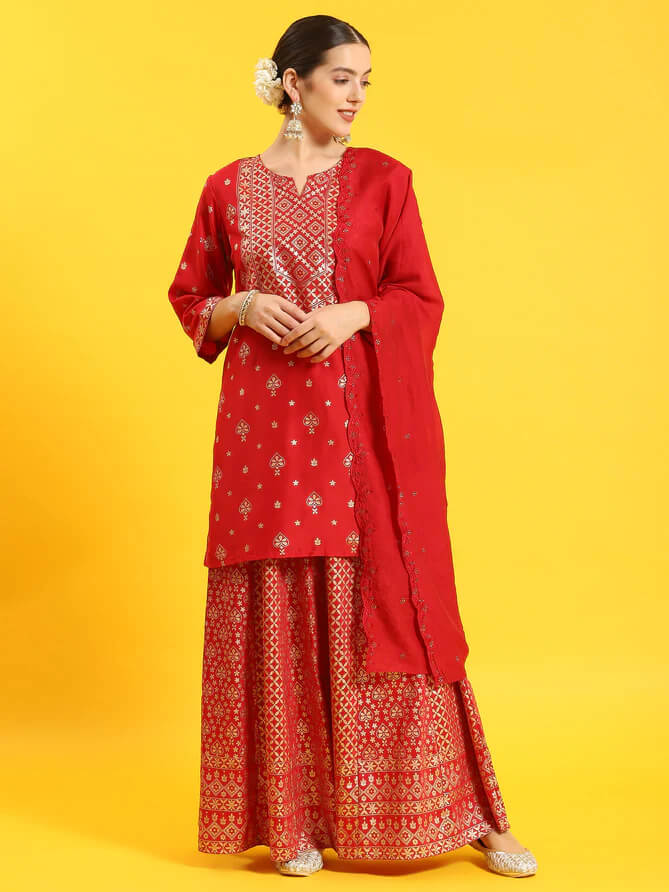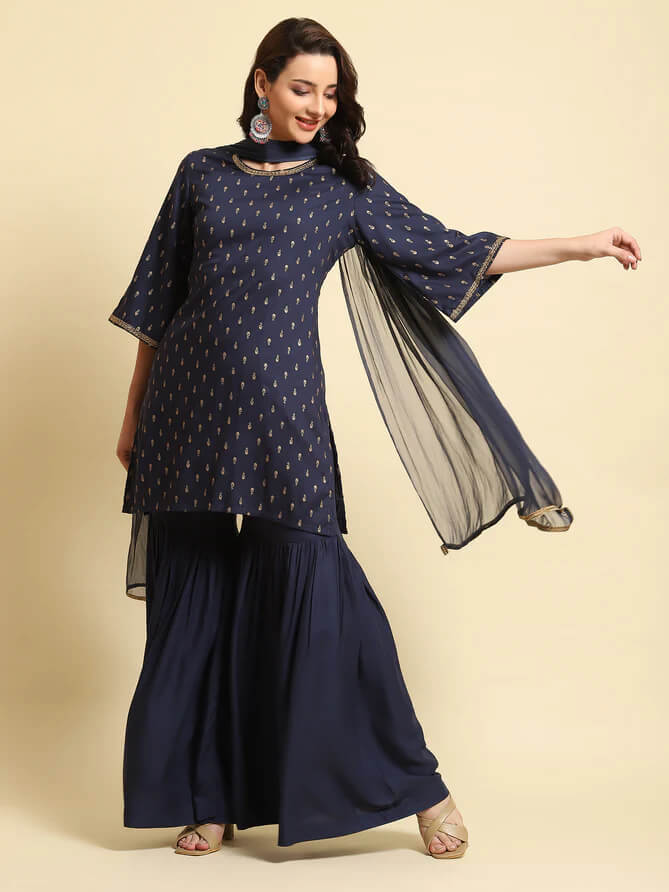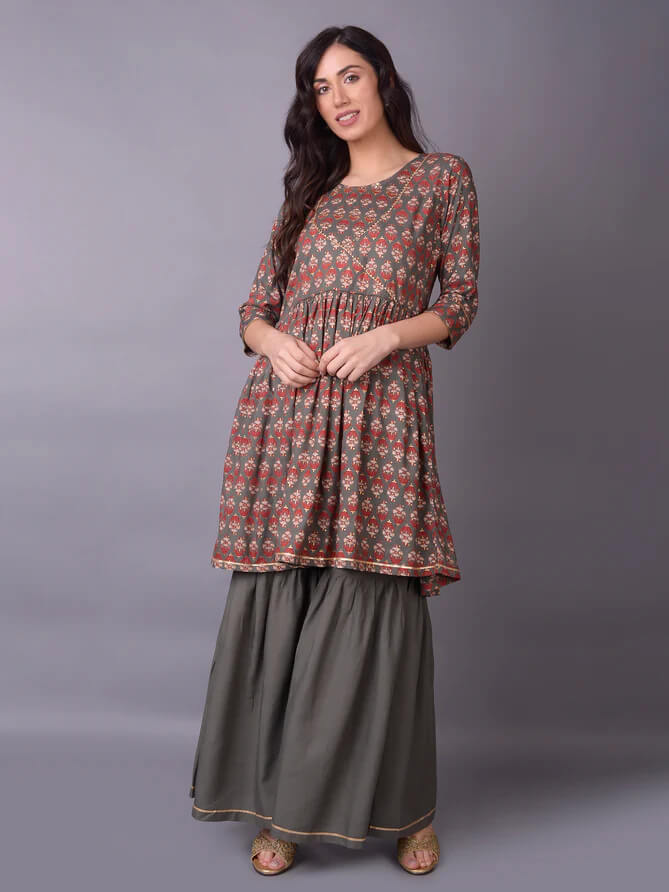Embrace Divine Femininity On Chaitra Navratri
Chaitra Navratri, a vibrant festival celebrated in India, marks the beginning of spring and honours the divine feminine energy. Spanning nine days, this festival is a time of devotion, reflection, and community celebration.
The Significance of Chaitra Navratri:
Chaitra Navratri holds immense cultural and spiritual significance. It symbolizes the triumph of good over evil, with devotees paying homage to Goddess Durga and her various incarnations. Each day of Navratri is dedicated to a different form of the goddess, known as Navadurga, who embodies different qualities and virtues.

Navratri is believed to be a time when the divine feminine energy is at its peak, and devotees seek blessings for prosperity, happiness, and spiritual fulfilment. The festival also marks the beginning of the agricultural season in many parts of India, with prayers offered to the goddess for a bountiful harvest.
The Colours of Navratri:
One of the fascinating aspects of Chaitra Navratri is the tradition of wearing specific colours on each day of the festival. These colours are believed to represent the energies associated with the respective forms of Goddess Durga and bring blessings and positivity to devotees.

Day-wise Colours and Their Meanings:
Day 1 (Pratipada): Red
Red symbolizes energy and vitality, representing the fierce form of Goddess Shailputri, the embodiment of purity and strength.
Start Navratri with a bang by wearing a stunning red saree or lehenga choli. Red symbolizes energy and vitality, perfectly complementing the fervour of the first day of festivities. Pair your outfit with gold jewellery and a bold red lip for a striking look.
Day 2 (Dwitiya): Royal Blue
Royal blue signifies grace and serenity, honouring Goddess Brahmacharini, who represents devotion and penance.
Embrace regal elegance on the second day of Navratri with a royal blue Anarkali suit or sharara set. Royal blue exudes grace and serenity, making it the perfect choice for invoking the divine energy of Goddess Brahmacharini. Add silver jewellery and a touch of shimmer to complete your ensemble.
Day 3 (Tritiya): Yellow
Yellow represents brightness and joy, reflecting the courage and optimism embodied by Goddess Chandraghanta.
Shine bright like the sun on the third day of Navratri with a gorgeous yellow salwar kameez or kurta set. Yellow represents brightness and joy, reflecting the optimism of Goddess Chandraghanta. Opt for statement earrings and a pop of contrasting colour to elevate your look.
Day 4 (Chaturthi): Green
Green symbolizes growth and abundance, paying tribute to Goddess Kushmanda, the creator of the universe.
Channel the lush beauty of nature on the fourth day of Navratri with a stunning green silk saree or an embroidered green lehenga. Green symbolizes growth and abundance, paying homage to Goddess Kushmanda. Accessorize with traditional gold jewellery and fresh floral accents for a verdant touch.
Day 5 (Panchami): Grey
Grey represents wisdom and stability, honouring Goddess Skandamata, the mother of Lord Kartikeya.
Embrace sophistication and wisdom on the fifth day of Navratri with an elegant grey Anarkali gown or a chic grey kurta with palazzo pants. Grey represents stability and balance, honouring the nurturing energy of Goddess Skandamata. Complete your look with silver jewellery and soft smoky eyes.
Day 6 (Shashthi): Orange
Orange signifies enthusiasm and determination, reflecting the attributes of Goddess Katyayani.
Infuse your wardrobe with warmth and vibrancy on the sixth day of Navratri with a striking orange lehenga or a flowing orange saree. Orange signifies enthusiasm and determination, reflecting the fiery spirit of Goddess Katyayani. Pair your outfit with gold accessories and a bold orange bindi for a captivating look.
Day 7 (Saptami): White
White symbolizes purity and peace, representing Goddess Kalratri, the fierce destroyer of darkness.
Embrace purity and serenity on the seventh day of Navratri with an ethereal white Anarkali suit or a pristine white saree or a kurta set. White symbolizes peace and tranquillity, embodying the divine grace of Goddess Kalratri. Keep your look minimalistic with silver jewellery and dewy makeup for an angelic vibe.
Day 8 (Ashtami): Pink
Pink signifies love and compassion, embodying the grace and beauty of Goddess Mahagauri.
Radiate love and compassion on the eighth day of Navratri with a beautiful pink lehenga choli or a pastel pink Anarkali gown. Pink signifies affection and tenderness, capturing the divine beauty of Goddess Mahagauri. Enhance your ensemble with delicate floral jewellery and rosy cheeks for a romantic touch.
Day 9 (Navami): Sky Blue
Sky blue represents tranquillity and infinity, honouring Goddess Siddhidatri, the bestower of spiritual powers.
Conclude Navratri on a serene note with a celestial sky-blue saree or an embellished sky blue kurta set or a beautiful tunic paired with jeans. Sky blue represents tranquillity and infinity, honouring the divine wisdom of Goddess Siddhidatri. Adorn yourself with silver accessories and a soft blue eyeshadow for a dreamy look.
Celebrating Chaitra Navratri:
During Chaitra Navratri, devotees observe fasting, perform rituals, and visit temples to seek the blessings of Goddess Durga. Homes and temples are adorned with flowers and lights, and devotional songs fill the air, creating a festive atmosphere of joy and reverence.

Throughout the nine days of Navratri, devotees engage in various rituals to honour Goddess Durga. These may include reciting prayers and mantras, performing aarti (rituals of worship), and offering prasad (sacred food) to the goddess. Many devotees also observe strict fasting during Navratri, abstaining from consuming certain foods and practicing austerity as a form of devotion.

Community Celebrations:
Navratri is not just a religious festival; it is also a time for social gatherings and cultural festivities. Communities come together to organize elaborate puja ceremonies, traditional dances such as Garba and Dandiya Raas, and cultural performances showcasing the rich heritage of India. These celebrations foster a sense of unity, camaraderie, and joy among participants, transcending barriers of caste, creed, and age.

Spiritual Significance:
Chaitra Navratri is a time for spiritual renewal and inner reflection, as devotees seek to deepen their connection with the divine. Through prayer, meditation, and acts of devotion, believers strive to purify their hearts and minds, seeking guidance and enlightenment from the goddess.

The festival also serves as an opportunity for self-improvement and personal growth, as devotees reflect on their values, goals, and aspirations. Many people use Navratri as a time to set intentions for the coming year, seeking blessings for success, happiness, and fulfilment in all areas of life.
Chaitra Navratri is not just a festival; it is a celebration of faith, devotion, and the indomitable spirit of the human soul. As we immerse ourselves in the colours, rituals, and traditions of Navratri, may we be inspired by the divine feminine energy embodied by Goddess Durga, and may her blessings fill our hearts with peace, prosperity, and spiritual fulfilment.
By embracing the symbolism of each day's colour and participating in the rituals and celebrations with sincerity and devotion, devotees can experience a profound sense of connection with the divine and with each other. Chaitra Navratri serves as a reminder of the enduring power of faith and the transformative potential of devotion, guiding us on a journey of self-discovery and spiritual growth.
As we come together to celebrate Chaitra Navratri, let us rejoice in the blessings of the goddess and the beauty of her creation. May this auspicious festival bring joy, peace, and prosperity to all, and may we emerge from it renewed and inspired to face life's challenges with courage and grace.
FAQs
- Can I wear the same colour outfit for Navratri every year?
Absolutely! While it's traditional to wear specific colours each day, there are no hard and fast rules. Feel free to express your style and creativity by wearing your favourite colours or experimenting with different hues each year.
- Are there any specific fabrics recommended for Navratri outfits?
Light and breathable fabrics like cotton, chiffon, georgette, and silk are ideal for Navratri outfits, as they offer comfort and ease of movement during the festivities.
- Can I mix and match different colours for my Navratri outfit?
Yes, you can certainly mix and match colours to create a unique and personalized Navratri outfit. Experiment with colour-blocking, contrasting dupattas, or embellished blouses to make a style statement.
- Do I need to wear traditional Indian attire for Navratri celebrations?
While traditional Indian attire like sarees, lehengas, and Anarkalis are popular choices for Navratri, you can also opt for fusion wear or contemporary outfits that reflect your personal style and preferences.
- Can I wear western outfits during Navratri celebrations?
While traditional Indian attire is traditionally worn during Navratri, there's no strict dress code. If you prefer western outfits, you can incorporate elements of Indian fashion such as statement jewellery or ethnic accessories to add a festive touch to your ensemble.
- What type of jewellery complements Navratri outfits?
Traditional Indian jewellery like jhumkas, chandbalis, kadas, and bangles beautifully complement Navratri outfits. Opt for gold, silver, or antique jewellery with intricate designs to enhance your look.
- Are there any specific hairstyles recommended for Navratri?
Hairstyles like braids, buns, and half-up half-down styles are popular choices for Navratri, as they complement traditional Indian attire and allow you to showcase your accessories like maang tikas and hairpins.
- Can I wear makeup with my Navratri outfit?
Yes, makeup can enhance your Navratri look and add an extra touch of glamour. Opt for dewy makeup with soft, neutral tones for a natural glow, or experiment with bold colours and statement makeup looks to make a statement.
- Are there any specific footwear options for Navratri outfits?
Comfortable footwear like juttis, mojaris, or sandals with a slight heel are ideal for Navratri, as they offer support and stability while dancing during the festivities.
- How can I accessorize my Navratri outfit?
Accessorize your Navratri outfit with statement jewellery like necklaces, earrings, and bangles, along with traditional accessories like bindis, maang tikas, and waist belts for an added touch of elegance.
- Can I wear floral prints or motifs for Navratri?
Yes, floral prints and motifs are a popular choice for Navratri outfits, especially during the spring season. Opt for outfits with subtle floral embroidery or bold floral prints to embrace the festive spirit.
- Can I wear traditional Navratri outfits for other festive occasions?
Absolutely! Traditional Navratri outfits are versatile and can be worn for other festive occasions like weddings, receptions, or religious ceremonies. Just mix and match your accessories to suit the occasion.











